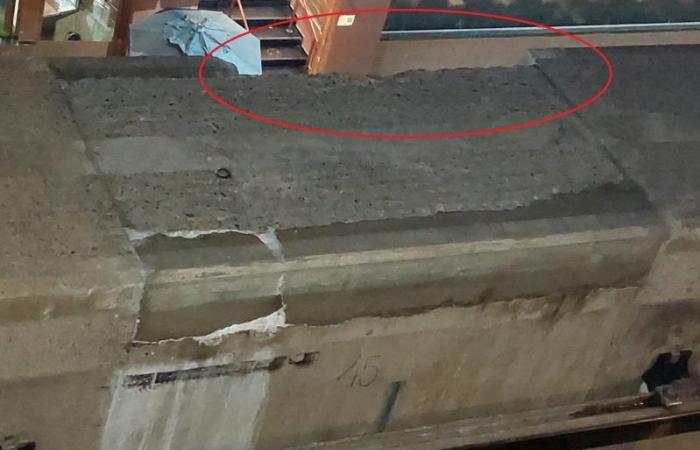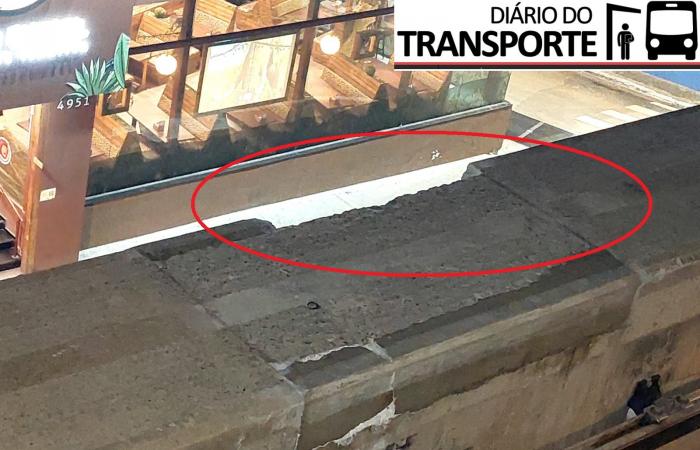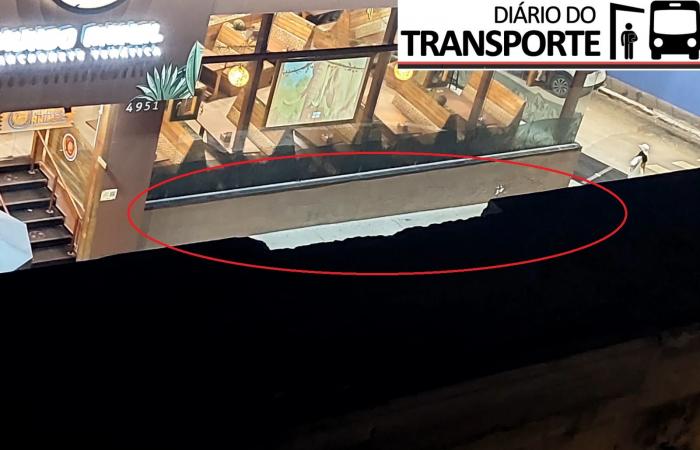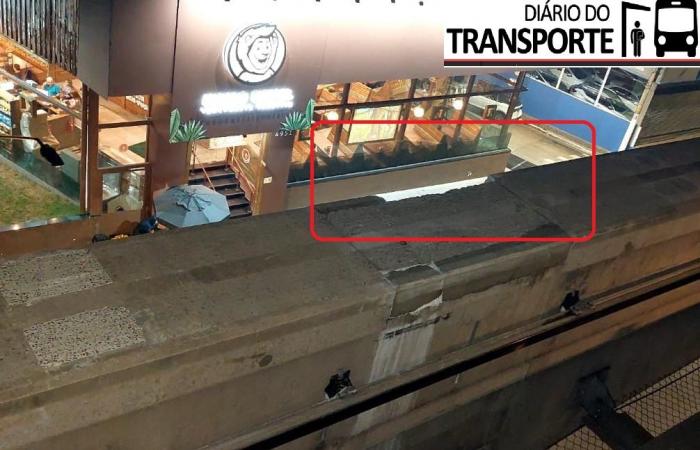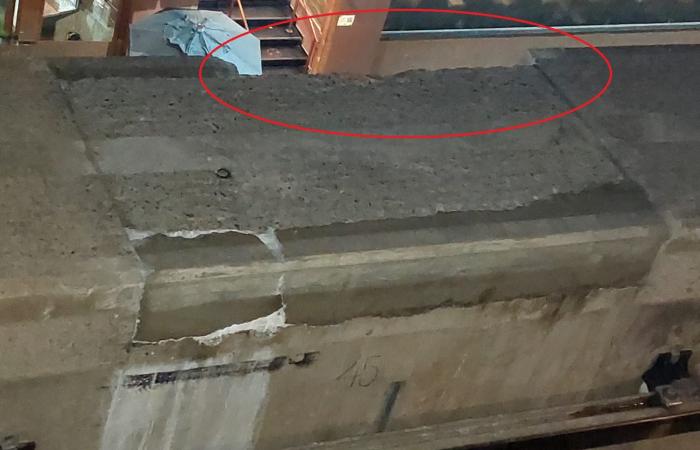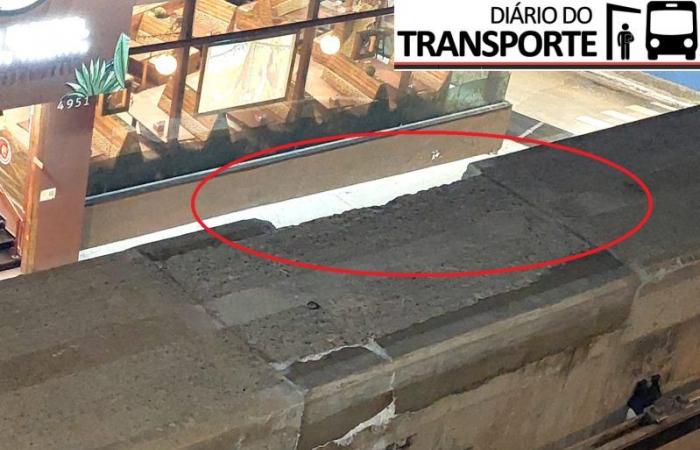Published: September 26, 2022
LISTEN TO THE FULL INTERVIEW HERE:
System officials point out that along the 15-Silver line, more pieces have also come off, in line with the MP’s conclusion about defects in the Monorail tracks.
ADAMO BAZANI
O Transport Diary reported first-hand this Friday, September 23, 2022, that a part of the monorail beam of line 15-Silver came loose and fell on the bike path on Avenida Luís Inácio de Anhaia Mello, between the stations Oratório and Parque São Lucas, in the eastern part of São Paulo.
According to the Metro’s internal incident report, part of the concrete came loose around 9 pm this Thursday (22).
21:23- Information – Through COPOM CCS, he was informed of the fall of pieces of structure on the monorail – a round was requested with the VTR in the vicinity between ORT and SLU and it was found that pieces of Pillar 45 had fallen on the bike path – SO2 Buissa aware for negotiations
Problems like this have been constantly reported by line employees and are in line with what the Public Ministry of São Paulo concluded in October 2021 about the burst of the inner part of a monorail wheel that resulted in the system being stopped for 100 days at the beginning. of 2020.
Remember:
https://diariodotransporte.com.br/2022/09/23/imagens-mosram-que-parte-de-viga-do-monotrilho-da-linha-15-prata-se-soltou-relato-tecnico-interno- realizes-the-pieces-fell-on-cycle-lane-on-thursday-night-22/
In response to transport diary, the São Paulo Metro admitted the situation, but said that there was no structural damage and that work had been carried out to remove the “excess cement” on the beam.
The building technician graduated from the Getúlio Vargas Technical School and architect and urban planner from FIAM FAAM (FMU), Raphael Toscano, carried out studies for his monograph, precisely on the monorail of the 15-Silver line.
The expert commented on the case technically with the Transport Diary and he was categorical in stating that what the images of the monorail beam show do not show that it was removed from the “excess cement”, as Metrô tried to argue.
“This excess of concrete does not exist when we talk about structure. This monorail beam is machined, pre-cast, ready-made. As evidenced in these photos, this concrete broke.” – explained
The technician says that the images show that what happened was a beam breakage.
“What people from the area can see is that there was a break in the upper flange of this precast concrete beam. And it is precisely at the top of the beam that the concrete receives the greatest compression from the rolling stock, which in this case is the monorail”
“We can clearly see that the beam suffered damage on both sides, and at the work, or later in the installation, the beam was redone just to maintain its profile aspect. There is no excess concrete in a structure. Or she wouldn’t be there.”
The specialist also says that it is not a simple “piece” that was missing. As he explained, every beam has a size developed precisely to support certain weights and certain forces and pressures. When there is this break, there is a decrease in the area, which is not beneficial, even though there is a kind of “safety margin” in the calculations.
Toscano also explained the seriousness of this type of problem in a system such as the monorail on line 15.
“Having a piece of the beam detached is like having a hole in the street while you are driving a car. Only in this case, there are several feet off the ground. Some piece can break and fall down, on the street, in a system that has no protection at all”.
The technician also explains that this type of problem with the beam can cause damage and risks to the trains.
“The system beam has a recess in the third part of its height that receives the coupling of the lateral stabilizer wheels of the train, which balance it during running. This broken tab at the top makes this tab disappear, leaving the profile straight and the wheel can slide up in case of sudden movement of the train. And this wheel sliding upwards during the movement, as it continues the course and finds the beam flap further ahead, it works like the side stabilizer wheel finds a step. It breaks right away.”
The specialist also said that if there is any breakage in the beam or a piece falling off, it is not enough to put cement to cover the missing area, which would only be an aesthetic solution.
These are beams that support a lot of weight and pressure with the movement of trains. It is necessary to do a real restoration work, often removing all the concrete material to the internal hardware of the structure and placing a new concreting so that the whole part becomes efficient and safe again.
Raphael Toscano warns of real risks for passengers, employees and for those who travel on the avenue below, whether on foot, by bicycle, car or bus, even though these vehicles are stronger.
“There may be a sudden reduction in speed of the monorail and passengers falling right through the wheels of the monorail passed through different profiles on the beam. For those below, it’s even worse. Imagine a piece of that concrete hitting the windshield of a vehicle. The height from which the piece of concrete is dropped is another factor. When falling, by the force exerted on the piece, weight can become ten times greater. Depending on the size of this piece, it can reach the bottom with such a weight that it can easily pierce the roof of a bus, even though this is a vehicle with a stronger structure than a smaller car” – explained.
Also a civil construction technician, Márcio Augusto Camargo, from ABC Estrutural, consulted by the report, said that the São Paulo Metro Company version needs to be further investigated.
“It is clear that a piece fell off and it was not excess cement” – said the specialist.
For Camargo, it is not common that after an alleged removal work, as alleged by the Metro, there is a failure as shown in the images.
“Everything had to be leveled and you can see that even a part is missing“ – opined
The technician also says that he finds it strange to have “excess” removal, as Metrô claimed in a work already done a long time ago.
“Usually, excesses are removed with the cement before curing. [fresco] or shortly afterwards. It’s only had a recent repair, but if it’s had a recent repair, it’s because you had a problem. In the images, right in the place where part of the beam is missing, nothing shows that maintenance work had been done on that occasion.”
The technician also points to other situations that highlight the images.
“There are patches that indicate different repair times, on the opposite side of where the piece would have come loose, on the same beam, the cement is darker, apparently younger than the rest of the beam. So, something was done there. Apart from the fact that this part that came loose had already been placed after construction, you can see the seam. Of course, it’s just a photo analysis, but it’s very evident that these wear and tear need to be better clarified, as well as what Metro is claiming”
The Sindicato dos Metroviários de São Paulo and Fenametro (Federação Nacional dos Metroviários) say that they have already pointed out several problems regarding the monorail, and that these reports were in line with experts who opined that the project would not be suitable for the route profile and demand of the region.
Adamo Bazani, journalist specializing in transport
See the images:




Adamo Bazani, journalist specializing in transport
Share the report on social media:
Tags: clear piece fell excess cement experts monorail beam risks

